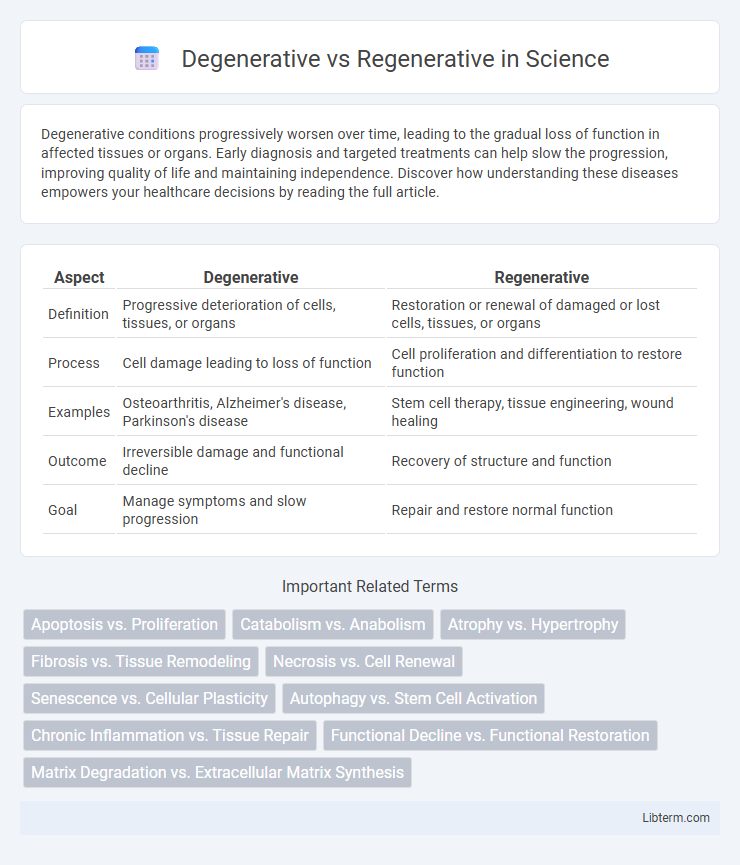Degenerative conditions progressively worsen over time, leading to the gradual loss of function in affected tissues or organs. Early diagnosis and targeted treatments can help slow the progression, improving quality of life and maintaining independence. Discover how understanding these diseases empowers your healthcare decisions by reading the full article.
Table of Comparison
| Aspect | Degenerative | Regenerative |
|---|---|---|
| Definition | Progressive deterioration of cells, tissues, or organs | Restoration or renewal of damaged or lost cells, tissues, or organs |
| Process | Cell damage leading to loss of function | Cell proliferation and differentiation to restore function |
| Examples | Osteoarthritis, Alzheimer's disease, Parkinson's disease | Stem cell therapy, tissue engineering, wound healing |
| Outcome | Irreversible damage and functional decline | Recovery of structure and function |
| Goal | Manage symptoms and slow progression | Repair and restore normal function |
Understanding Degenerative and Regenerative Concepts
Degenerative processes involve the progressive deterioration of cells, tissues, or organs, leading to loss of function and structural integrity over time. Regenerative mechanisms, by contrast, enable the repair, replacement, or restoration of damaged biological components through cellular regeneration and tissue engineering. Understanding the molecular pathways and cellular behaviors underlying degeneration and regeneration is crucial for developing advanced therapeutic strategies in regenerative medicine and neurodegenerative disease treatment.
Key Differences Between Degenerative and Regenerative Processes
Degenerative processes involve the gradual deterioration of cells, tissues, or organs, leading to functional decline commonly seen in diseases like osteoarthritis and Alzheimer's. Regenerative processes, by contrast, enable the repair or replacement of damaged tissues through mechanisms such as stem cell activation and tissue engineering. Key differences include the irreversible nature of degeneration versus the potential for restoration in regeneration, along with their distinct molecular pathways involving catabolic versus anabolic activities.
Causes of Degenerative Changes
Degenerative changes primarily result from aging processes, mechanical wear and tear, and chronic inflammation affecting tissues such as cartilage, intervertebral discs, and joints. Genetic predisposition, repetitive strain injuries, and metabolic disorders like osteoarthritis exacerbate the breakdown of collagen and proteoglycans, leading to loss of tissue integrity. Environmental factors, including poor nutrition and smoking, further accelerate degenerative pathology by impairing cellular repair and promoting oxidative stress.
Principles of Regeneration and Renewal
Regenerative principles emphasize restoring function through cellular repair, differentiation, and tissue remodeling, leveraging stem cells and growth factors to stimulate natural healing processes. In contrast to degenerative conditions characterized by progressive tissue deterioration and loss of function, regeneration aims to rebuild structures at the molecular and cellular levels, promoting sustainability and long-term recovery. Advanced regenerative therapies target the activation of intrinsic repair mechanisms, supporting renewal by mitigating inflammation, enhancing extracellular matrix composition, and facilitating angiogenesis.
Degenerative Diseases: Common Examples
Degenerative diseases involve the progressive deterioration of cells, tissues, or organs, often leading to chronic and debilitating conditions. Common examples include Alzheimer's disease, Parkinson's disease, amyotrophic lateral sclerosis (ALS), and osteoarthritis, each characterized by the gradual loss of function in specific body systems. These diseases frequently result from genetic factors, aging, environmental influences, and lifestyle choices, highlighting the importance of early diagnosis and targeted interventions.
Regenerative Medicine: Innovations and Approaches
Regenerative medicine harnesses stem cell therapy, tissue engineering, and gene editing to repair or replace damaged tissues, offering solutions beyond conventional degenerative disease treatments. Innovative approaches such as 3D bioprinting and personalized cell therapies enhance the effectiveness of regenerating organs and restoring function. Key advancements include the use of induced pluripotent stem cells (iPSCs) and extracellular matrix scaffolds, which promote natural healing and tissue integration.
Impact on Health and Quality of Life
Degenerative conditions, such as osteoarthritis and Alzheimer's disease, progressively worsen tissue function, leading to chronic pain, reduced mobility, and cognitive decline that significantly impair health and quality of life. Regenerative approaches, including stem cell therapy and tissue engineering, aim to restore damaged tissues and improve function, offering potential for reversing symptoms and enhancing physical and mental well-being. Effective regenerative treatments can reduce dependency on long-term medications and improve daily living activities, thereby promoting a higher quality of life compared to traditional degenerative condition management.
Preventing Degeneration: Lifestyle and Interventions
Preventing degeneration involves adopting a lifestyle rich in antioxidants, regular physical activity, and a balanced diet to combat oxidative stress and inflammation that contribute to tissue breakdown. Interventions such as early medical screenings, targeted supplements like omega-3 fatty acids, and therapies including physical rehabilitation and neuroprotective treatments play crucial roles in slowing degenerative processes. Emphasis on maintaining cellular health and promoting regeneration through stem cell research and regenerative medicine offers promising avenues to counteract or delay degeneration effectively.
The Future of Regenerative Therapies
Regenerative therapies harness stem cells, tissue engineering, and gene editing to repair or replace damaged tissues, offering promising solutions for degenerative diseases like osteoarthritis and neurodegenerative disorders. Advances in biomaterials, 3D bioprinting, and personalized medicine accelerate the development of effective regenerative treatments, potentially reversing conditions that currently require lifelong management. The future of regenerative medicine lies in integrating multi-omics data and artificial intelligence to optimize patient-specific therapies, driving a paradigm shift from symptom management to true tissue regeneration and functional restoration.
Choosing Between Degenerative and Regenerative Approaches
Choosing between degenerative and regenerative approaches depends on the specific medical condition and desired outcomes. Degenerative methods often involve managing symptoms and slowing deterioration, while regenerative approaches aim to restore damaged tissues through techniques like stem cell therapy or tissue engineering. The decision hinges on factors such as disease stage, patient health, and available resources for effective long-term recovery.
Degenerative Infographic

 libterm.com
libterm.com